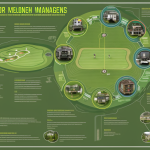Golf is a sport that requires precision, skill, and strategy. Choosing the right golf course is crucial to enhance your overall golfing experience. But how do you know if a golf course is good? In this comprehensive guide, we will explore the key factors that determine the quality of a golf course. From the design and layout to the condition of the greens and the amenities offered, we will delve into each aspect to help you make an informed decision. Whether you’re a seasoned golfer or a beginner, this guide will provide you with valuable insights to elevate your game and enjoy your time on the course. So, get ready to tee off and discover the secrets to identifying the best golf courses out there!
Understanding the Factors That Contribute to a Good Golf Course
Design and Layout
A golf course’s design and layout play a crucial role in determining its overall quality. A well-designed golf course can offer a challenging and enjoyable experience for golfers of all skill levels, while a poorly designed course can lead to frustration and disappointment. In this section, we will explore the role of a golf course architect, the importance of a well-designed golf course, and common design elements of a good golf course.
- The role of a golf course architect
A golf course architect is responsible for designing and planning the layout of a golf course. They must take into account a variety of factors, including the natural terrain, water features, vegetation, and topography, to create a course that is both aesthetically pleasing and challenging for golfers. Golf course architects must also consider the skill level of the target audience and the overall goals of the course, such as promoting environmental sustainability or providing a unique golfing experience. - Importance of a well-designed golf course
A well-designed golf course can offer a variety of benefits for golfers and the surrounding community. A well-designed course can be more challenging and enjoyable for golfers, while also promoting environmental sustainability and protecting natural resources. Additionally, a well-designed course can enhance the value of the surrounding real estate and boost the local economy. - Common design elements of a good golf course
There are several common design elements that are typically found in well-designed golf courses. These include:- Variety of hole lengths and difficulty levels
- Proper use of hazards, such as water and bunkers
- Proper use of terrain, including elevation changes and doglegs
- Strategic use of fairway width and green size
- Integration of natural features, such as trees and rocks
- Use of appropriate turfgrasses and maintenance practices to ensure good playing conditions
- Proper drainage and irrigation systems to protect the course from weather-related damage
- Proper routing of the course to create a logical flow and minimize repetition
- Use of amenities, such as clubhouses and practice facilities, to enhance the overall golfing experience.
Maintenance and Conditioning
A well-maintained golf course is a crucial factor in determining its overall quality. Poor maintenance can lead to unsightly and hazardous conditions that can detract from the enjoyment of the game. Conversely, a golf course that is well-maintained can provide a more enjoyable experience for golfers of all skill levels.
The condition of a golf course is affected by several factors, including climate, foot traffic, and the use of golf carts. Extreme weather conditions, such as heavy rain or extreme heat, can cause damage to the course and make it difficult to maintain. Foot traffic, particularly on the greens, can also cause wear and tear, making it more difficult to maintain the smoothness and consistency of the putting surface. The use of golf carts can also contribute to wear and tear on the course, particularly on the rough and around the tee boxes.
Golf course superintendents play a crucial role in maintaining the condition of the course. They are responsible for overseeing the maintenance crew and ensuring that the course is properly maintained and prepared for play. This includes tasks such as mowing, fertilizing, and watering the grass, as well as maintaining the bunkers, greens, and fairways. A skilled superintendent can help to ensure that the course is in top condition, even in challenging weather conditions.
In addition to the visual appearance of the course, the condition of the turf can also affect the playability of the course. Poorly maintained greens can be slow and bumpy, making it difficult to accurately judge the line and speed of a putt. Roughs that are not properly maintained can be difficult to hit out of, particularly for higher handicap golfers.
Overall, the condition of a golf course is a critical factor in determining its quality. A well-maintained course will provide a more enjoyable experience for golfers, while poor maintenance can detract from the enjoyment of the game. Golf course superintendents play a crucial role in maintaining the condition of the course, and their skills and expertise can help to ensure that the course is in top condition for players of all skill levels.
Variety and Challenge
Golf courses are designed to challenge players while providing them with a pleasant and enjoyable experience. To achieve this balance, course designers must consider various factors that contribute to the overall quality of a golf course. Two critical factors that impact the quality of a golf course are variety and challenge.
The Importance of Variety in a Golf Course
A golf course should offer a variety of holes that present different challenges to players. This variety can come in many forms, such as the length of the hole, the shape of the fairway, the placement of hazards, and the angle of the slope. A course that lacks variety can become monotonous and fail to challenge players, resulting in a poor golfing experience.
Factors That Contribute to the Challenge of a Golf Course
The challenge of a golf course comes from the design of the holes and the placement of hazards. Designers must carefully consider the length of the hole, the placement of the green, and the strategic locations of hazards to create a course that is both challenging and fair. In addition, the terrain of the course can also contribute to the challenge, with hilly or mountainous courses requiring more skill and precision from players.
Creating a Balance Between Variety and Challenge
Creating a balance between variety and challenge is crucial to designing a great golf course. A course that is too challenging can be frustrating for players, while a course that lacks challenge may not provide an enjoyable experience. Designers must carefully consider the skill level of the players who will be using the course and adjust the difficulty of the holes accordingly. By striking the right balance between variety and challenge, golf course designers can create a course that is both enjoyable and challenging for players of all skill levels.
Evaluating the Quality of a Golf Course
Playing the Course
Playing a golf course is an essential part of evaluating its quality. By playing the course, you can assess the design, layout, and condition of the golf course. Here are some factors to consider when playing a golf course to evaluate its quality:
- Course Design: The design of a golf course is an important factor in determining its quality. A well-designed golf course will have a good layout that makes it challenging and enjoyable to play. Consider the placement of hazards, the positioning of greens, and the overall flow of the course.
- Condition of the Course: The condition of the golf course is another important factor to consider when evaluating its quality. A well-maintained golf course will have well-manicured fairways, smooth greens, and properly maintained bunkers and hazards. The condition of the course can significantly impact the playing experience.
- Playability: The playability of a golf course is also an important factor to consider. A golf course that is challenging but fair is more likely to be considered high quality. Consider the difficulty of the course, the width of the fairways, and the size of the greens when evaluating playability.
- Amenities: Amenities such as the clubhouse, pro shop, and practice facilities can also impact the overall quality of a golf course. Consider the quality of the amenities when evaluating the course.
To evaluate the quality of a golf course effectively, it is essential to play it several times under different conditions. This will help you to get a better understanding of the course’s strengths and weaknesses. It is also recommended to play with different groups of people to get a range of opinions on the course’s quality.
Reviewing Course Ratings and Reviews
When evaluating the quality of a golf course, course ratings and reviews play a crucial role in providing valuable insights and opinions from fellow golfers. Here’s a closer look at how course ratings and reviews can help you make an informed decision:
The role of course ratings and reviews in evaluating a golf course’s quality
Course ratings and reviews provide an objective and subjective assessment of a golf course’s quality, helping potential players make an informed decision. They can offer insights into the course’s design, condition, playability, and overall experience.
Ratings and reviews are often based on various factors, such as:
- Course layout and design
- Playability and difficulty
- Condition of the course and its facilities
- Customer service and staff friendliness
- Value for money
Popular golf course rating systems
Popular golf course rating systems include:
- Golf Digest’s America’s 100 Greatest Golf Courses: This list features the top 100 golf courses in the United States, as ranked by Golf Digest’s panel of experts.
- Golf Magazine’s Top 100 Courses You Can Play: This ranking considers the best public-access courses in the United States that offer a great golfing experience for players of all skill levels.
- Golfweek’s Best Classic and Modern Courses: Golfweek’s rankings cover both classic and modern courses, evaluating their design, routing, and overall golfing experience.
- The World’s 100 Greatest Golf Courses (as determined by various golf publications): This list ranks the best golf courses globally, featuring a diverse range of courses that offer exceptional golfing experiences.
Reading and interpreting golf course reviews
When reading golf course reviews, consider the following factors:
- Date of the review: Keep in mind that reviews may be outdated, so consider the date of the review and how it might have influenced the course’s current condition or experience.
- Reviewer’s golfing skill level: Different golfers have varying skill levels and preferences, so it’s essential to consider the reviewer’s perspective based on their experience.
- Course-specific details: Look for specific details about the course, such as comments on the design, condition, facilities, and overall experience.
- Pros and cons: Pay attention to both the positive and negative aspects mentioned in the review, as this can help you make a more balanced evaluation of the course.
In conclusion, reviewing course ratings and reviews can provide valuable insights into a golf course’s quality, helping you make an informed decision when selecting a course to play.
Considering Professional Opinions
Seeking professional opinions is a valuable step in evaluating the quality of a golf course. Golf course architects, designers, and other industry experts possess a wealth of knowledge and experience that can help you identify the strengths and weaknesses of a course.
Qualities to look for in a professional golf course evaluator include:
- Expertise in golf course design and architecture
- Familiarity with the local golf scene and trends
- Objectivity and impartiality
- Attention to detail and ability to identify both positive and negative aspects of a course
To find a professional golf course evaluator, consider reaching out to:
- Golf course architects and designers
- Golf course rating organizations
- Golf course consultants
- Golf industry associations
By incorporating professional opinions into your evaluation process, you can gain a more comprehensive understanding of a golf course’s quality and make informed decisions about its potential for improvement or maintenance.
Using a Checklist
Creating a checklist to evaluate a golf course’s quality is an effective way to ensure that all aspects of the course are considered. The checklist should include factors that are essential to the overall experience of playing the course. By using a checklist, evaluators can objectively assess the quality of a golf course and identify areas that need improvement.
Here are some factors to include in a golf course evaluation checklist:
- Course Design: The design of the course should be evaluated for its overall aesthetic appeal, as well as its strategic and technical challenges. The layout of the course should be such that it makes optimal use of the natural terrain and features, while also providing a variety of hole lengths and shot options.
- Conditioning: The condition of the course’s turf, tees, fairways, greens, and rough should be evaluated. The course should be well-maintained, with consistent and smooth putting surfaces, and few unrepaired divots or ball marks.
- Facilities and Amenities: The quality of the course’s facilities, such as the clubhouse, locker rooms, and dining areas, should be evaluated. The course should also offer amenities such as cart rentals, range balls, and practice areas.
- Playability: The course’s playability should be evaluated based on its overall difficulty, including the length of the holes, the presence of hazards, and the strategic options available to players. The course should be challenging but fair, with a variety of hole lengths and shot options.
- Accessibility: The course’s accessibility should be evaluated, including the availability of transportation and parking, as well as the course’s location and proximity to accommodations.
By using a checklist to evaluate a golf course, evaluators can ensure that all aspects of the course are considered, and that the course is meeting the standards expected by golfers. The checklist can also serve as a useful reference for identifying areas that need improvement and for tracking the course’s progress over time.
Improving the Quality of a Golf Course
Identifying Areas for Improvement
Improving the quality of a golf course requires identifying areas where changes can be made to enhance the overall experience for players. There are several methods for identifying areas for improvement, including:
- Player feedback: Gathering feedback from players about their experience on the course can provide valuable insights into areas that need improvement. This can be done through surveys, focus groups, or individual interviews.
- Course maintenance staff: The course maintenance staff has a unique perspective on the course and can identify areas that need improvement based on their day-to-day experiences.
- Golf course architects: Golf course architects can provide an objective perspective on the course and can identify areas where changes can be made to improve the flow and playability of the course.
It is important to note that continuous improvement is key to maintaining a high-quality golf course. The golf industry is constantly evolving, and courses must adapt to stay relevant. However, it is also important to balance improvements with preserving the course’s original design and character. Making changes that are not in line with the course’s original design can alter its unique identity and appeal to players.
Golf Course Renovation Process
Golf course renovation is a process that involves making improvements to an existing golf course in order to enhance its quality and playability. The renovation process can include a wide range of changes, from minor modifications to major overhauls. In this section, we will explore the golf course renovation process in more detail, including the factors to consider when planning a renovation and the importance of hiring a qualified golf course architect.
Overview of the Golf Course Renovation Process
The golf course renovation process typically begins with an assessment of the existing course to identify areas that need improvement. This assessment may include a review of the course’s layout, drainage, irrigation, and turf conditions, as well as an evaluation of the course’s overall playability and aesthetics.
Once the areas that need improvement have been identified, the renovation process can begin. This may involve removing and replacing turf, reshaping bunkers and greens, redesigning fairways, and making other changes to improve the course’s overall layout and playability.
Factors to Consider When Planning a Golf Course Renovation
When planning a golf course renovation, there are several factors that should be considered in order to ensure the best possible results. These factors may include:
- The course’s existing layout and features
- The goals of the renovation project
- The course’s budget and timeline
- The needs and preferences of the course’s users
- The local environment and ecology
The Importance of Hiring a Qualified Golf Course Architect
One of the most important factors in a successful golf course renovation is the hiring of a qualified golf course architect. A golf course architect is responsible for designing and overseeing the renovation process, and must have a deep understanding of golf course design principles, as well as experience working with local regulations and environmental concerns.
A qualified golf course architect can help to ensure that the renovation process is carried out in a way that enhances the course’s quality and playability, while also taking into account the needs and preferences of the course’s users and the local environment.
In conclusion, the golf course renovation process is a complex undertaking that requires careful planning and execution. By considering the factors discussed in this section and hiring a qualified golf course architect, golf course owners and managers can ensure that their renovation projects are successful and result in a high-quality golf course that meets the needs and expectations of its users.
Maintaining Quality Over Time
The Importance of Maintaining a Golf Course’s Quality Over Time
The upkeep of a golf course is a continuous process that requires constant attention to detail. The condition of the course has a direct impact on the overall experience of golfers, influencing their decision to return or choose another course. Therefore, it is crucial to maintain the quality of a golf course over time to ensure customer satisfaction and attract new players.
Strategies for Maintaining a Golf Course’s Quality
A well-maintained golf course is the result of a comprehensive plan that involves regular maintenance tasks, such as mowing, fertilizing, and irrigating. It also includes implementing long-term strategies, such as tree planting and drainage improvements, to enhance the playing conditions and aesthetics of the course. Some strategies for maintaining a golf course’s quality include:
- Regular mowing: The grass on the fairways, greens, and roughs should be cut to the appropriate height to ensure optimal playing conditions and aesthetics.
- Fertilization: Fertilizers are applied to the turf to promote healthy growth and maintain a vibrant green color.
- Irrigation: Watering the course is essential to maintain healthy turf and prevent dryness, especially during hot and dry periods.
- Pest control: Pesticides and herbicides are used to control weeds, insects, and other pests that can damage the turf and affect playing conditions.
- Drainage improvements: Improving drainage helps to prevent water accumulation on the course, reducing the risk of flooding and improving playing conditions during wet periods.
- Tree planting: Planting new trees and maintaining existing ones helps to create shade, improve aesthetics, and protect the course from wind erosion.
Adapting to Changing Environmental Conditions and Technology Advancements
Adapting to changing environmental conditions and technology advancements is crucial for maintaining the quality of a golf course. Climate change, for example, can lead to more frequent droughts, heatwaves, and extreme weather events, which can affect the playing conditions and aesthetics of the course. To address these challenges, golf course managers should consider implementing the following strategies:
- Implementing water-saving technologies: Installing efficient irrigation systems and using drought-resistant grass varieties can help to reduce water usage and maintain the course during dry periods.
- Adapting to extreme weather events: Preparing for severe weather events, such as hurricanes and floods, by creating emergency plans and implementing stormwater management systems can help to minimize damage to the course.
- Embracing sustainable practices: Using eco-friendly practices, such as solar panels and rainwater harvesting, can help to reduce the environmental impact of the course and save costs in the long run.
- Updating equipment and technology: Using the latest technology, such as GPS-controlled mowers and precision irrigation systems, can help to improve efficiency and playing conditions while reducing costs and labor requirements.
FAQs
1. What are the key factors to consider when assessing the quality of a golf course?
When assessing the quality of a golf course, there are several key factors to consider. These include the overall design and layout of the course, the condition of the fairways, greens, and other playing surfaces, the variety and challenge of the holes, the quality of the amenities and facilities, and the level of service provided by the staff.
2. How do you evaluate the design and layout of a golf course?
To evaluate the design and layout of a golf course, you should consider factors such as the use of natural features, the placement of hazards and other obstacles, the variety of hole distances and pars, and the overall flow and rhythm of the course. A well-designed golf course will be visually appealing, challenging, and enjoyable to play.
3. How important is the condition of the playing surfaces on a golf course?
The condition of the playing surfaces on a golf course is extremely important when assessing its quality. The fairways, greens, and other playing surfaces should be well-maintained, consistent, and true. Poorly maintained playing surfaces can lead to frustration and disappointment for golfers, and can negatively impact their overall experience on the course.
4. How do you determine the variety and challenge of the holes on a golf course?
To determine the variety and challenge of the holes on a golf course, you should consider factors such as the length and shape of the holes, the placement of hazards and other obstacles, the use of elevation changes, and the overall difficulty of the course. A well-designed golf course will offer a range of challenges and opportunities for golfers of all skill levels to enjoy and improve their game.
5. How do you evaluate the quality of the amenities and facilities on a golf course?
To evaluate the quality of the amenities and facilities on a golf course, you should consider factors such as the clubhouse, locker rooms, pro shop, dining options, and practice facilities. A high-quality golf course will offer a range of amenities and facilities that are well-maintained, modern, and convenient for golfers.
6. How important is the level of service provided by the staff on a golf course?
The level of service provided by the staff on a golf course is an important factor when assessing its quality. The staff should be friendly, knowledgeable, and helpful, and should provide a high level of service to golfers. A well-staffed golf course will create a positive and enjoyable experience for golfers, and can make a significant difference in their overall satisfaction with the course.









